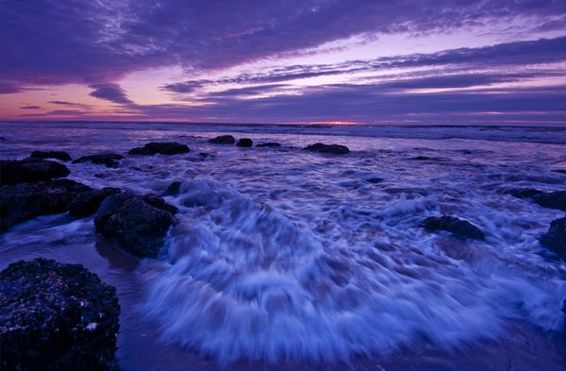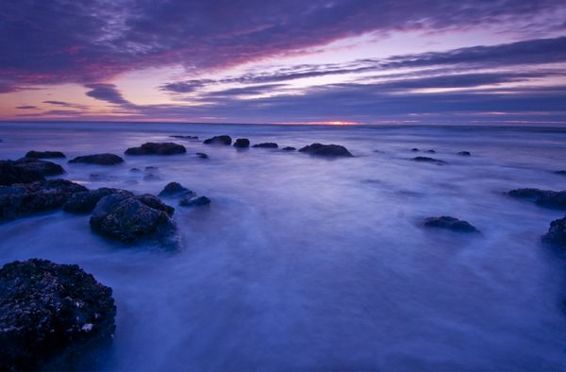THE SOLUTION
Here are some general guidelines to follow when creating motion-filled images. These should provide a good starting point when you’re setting up your shot.
• A 1/2-sec. exposure will produce a smooth, cottony look in waterfalls and streams.
• A 1/4-sec. exposure will make hands knitting a sweater appear as if they were moving at a very high rate of speed.
• A 30-mph wind moving through a stand of trees coupled with a 1-second exposure will usually render a composition of sharply focused trunks and branches, while the leaves appear wispy, fluttering, and overlapping.
In order to use these slow shutter speeds while maintaining a correct exposure, you will likely end up using the lowest ISO number and the smallest lens opening your camera offers. Essentially, you are trying to limit the amount of light hitting your sensor so that you can leave the shutter open for a longer period of time without overexposing the image. You also may need to call on a polarizing filter and/or a neutral-density filter for the same purpose; both reduce the amount of light hitting the sensor.
TIP: SLOWING YOUR SHUTTER SPEED WITH POLARIZING VERSUS NEUTRAL-DENSITY FILTERS
Polarizing filters can reduce your exposure by only 2 stops, while neutral-density (ND) filters are available in 1- to 12- stop increments. There is also the “all-in-one” Tiffen 2- to 8-stop ND filter that changes density from 2 to 8 stops as you rotate the outer ring. Personally, I use the Tiffen a great deal, far more often than the polarizing filter when my sole aim is to slow shutter speeds.
Waterfalls are great subjects for photographers first discovering the magic of slow shutter speeds. When it comes to implying the smooth, cotton-candy motion of falling water, a slow shutter speed of at least 1/4 sec. is necessary.
It was a rainy, overcast day when I captured this scene, which made my life easier because I wanted to use a slow shutter speed. To limit the light hitting the sensor, and because I wanted a great depth of field, I chose an aperture of f/22 and an ISO of 100. In addition, I placed my polarizing filter on the lens to reduce, if not eliminate, the gray glare from the dull sky overhead. Without the filter, that glare would have reflected off the wet leaves and rocks (see also How to Reduce Reflected Glare on Sunny and Cloudy Days). I then adjusted my shutter speed until 1/2 sec. indicated a correct exposure.
A slow shutter speed records the motion of the
waterfall.
12–24mm lens, f/22 for 1/2
sec.
Fortunately, a low tide along Oregon’s beautiful coastline, near Lincoln City, coincided with this sunset. I had no trouble finding some exposed rocks to climb on top of for an elevated position. I wanted to convey the energy of the incoming surf. The only way to do that was by selecting the right shutter speed.
With my camera and 12–24mm lens mounted to a tripod, I selected a shutter speed of 1/15 sec., slow enough to render the wave as a subtle blur, and adjusted my aperture until f/8 indicated a correct exposure. Then I played the waiting game, watching for a wave that had enough energy to flow into the entire frame, top to bottom. Within a couple of minutes, I saw my wave and captured it in the first image.
A few seconds later, I shifted gears, choosing now to convey the mighty ocean as a calm and tranquil landscape. With the aid of my Tiffen variable 2- to 8-stop ND filter set at a 5-stop reduction, I then decreased my aperture to f/22. This gave me a total of 8 stops of reduced light, and if we do the math, it is no surprise that I ended up with a 15-second exposure (1/8 sec. to 1/4 sec. to 1/2 sec. to 1 second to 2 seconds to 4 seconds to 8 seconds and finally to 15 seconds). Clearly, the message of this second image is radically altered, from “a force to be reckoned with” to something far more docile. Both images are effective, but by deliberately manipulating the shutter speed (and using an ND filter), I changed the feel of the composition completely.
A shutter speed of 1/15 sec. conveys the power of the
ocean.
12–24mm lens, f/8 for 1/15
sec.
By slowing the shutter speed further, I shifted the
image’s tone dramatically.
12–24mm lens, f/22 for 15 seconds with 2- to
8-stop ND filter set to 5-stop reduction


